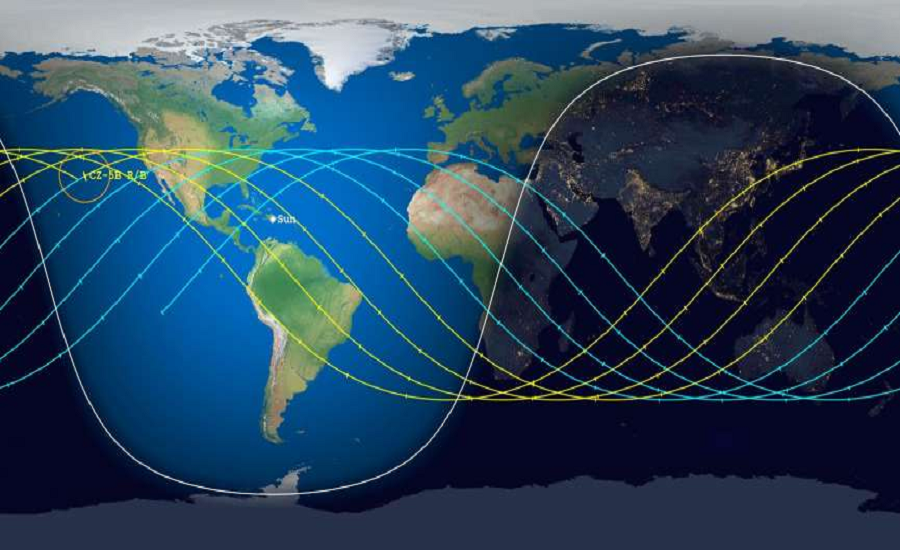
Update: The United States’ 18th Space Control Squadron has confirmed that the spent rocket stage re-entered the atmosphere over the Atlantic Ocean away from any land at 11:33am ET today, May 11, 2020.
A large Chinese rocket is projected to crash somewhere around the Earth tomorrow; odds have increased that it would do so somewhere around the United States or its adjacent waters.

While the United States has been busy preparing to launch humans from U.S. soil again, China has been actively preparing to do the same. On Tuesday, China launched their heavy-lift Long March 5b rocket, carrying a test model of a next-generation Chinese crew capsule to space. The large 176 foot tall rocket, featuring 10 main engines, lifted off from the Wenchang Satellite Launch Center on Hainan Island in southern China. While Hainan Island features Sanya and several high-end ultra-luxury resorts, it also is home to secretive military bases and the spaceport.
The Long March 5, developed by the China Academy of Launch Vehicle Technology, roughly matches the capabilities of American rockets like the ULA Delta IV Heavy and the SpaceX Falcon Heavy. The massive rocket that was used to bring the GOES-R and GOES-S weather satellites to orbit was a ULA Atlas V; despite it’s size, it’s considerably smaller and less powerful than the Long March 5.
The Wenchang facility on Hainan Island allows launch vehicles to soar over the South China Sea; previous launches lifted-off from inland launch facilities, forcing used rocket stages to fall onto land. Previous rocket stages have crashed into people’s homes in China. In the United States, such launches lift-off from launchpads near water, allowing spent rocket stages to tumble back to the ocean. Prior to such an event, NASA in partnership with local government agencies, put the projected splash-down area as a “no-fly” / “no-boat” area until the debris is safely down.

However, it appears the spent Long March 5 main stage will tumble back to Earth in an uncontrolled manner, potentially threatening some location on the planet with an impact. While experts believe much of the large spent rocket stage will burn-up upon re-entry, it is possible some parts of it, such as its massive motors, may survive re-entry and impact Earth. The spent rocket stage is roughly 100 feet long by 16 feet wide. This is approximately the same size as 4 school buses, parked 2 by 2.
Aerospace Corporation is tracking the falling space debris. In March of 2018, Aerospace also tracked a falling Chinese space station. It eventually crashing into the ocean. Because the spent rocket is returning to Earth in an uncontrolled manner, experts are not completely certain where it will fall. A projection shared by Aerospace Corporation yesterday suggested a re-entry could happen near South Africa. Today, the estimate has shifted to an area between Hawaii and California. However, that location can change too, with impact possible under anywhere the debris is currently orbiting. In the latest forecast, impact could happen within 7 hours tomorrow of 12:38pm ET, 9:38am PT, and 6:38am HT. With a 7 hour window, that means it could fall as early as 5:38am ET, 2:28am PT, or 11:38pm tonight HT; it could also fall as late as 7:38pm ET, 4:38pm PT, and 1:38pm HT.
The U.S. Space Force is tracking the falling Chinese rocket. Created in December, the U.S. Space Force has been busy. Just weeks ago, the U.S. Space Force was tracking Russian assets that were deployed to destroy satellites in space. If an entity in space or tumbling from space were to threaten U.S. interests, they’d work in partnership with other military branches and government teams to respond to the threat.